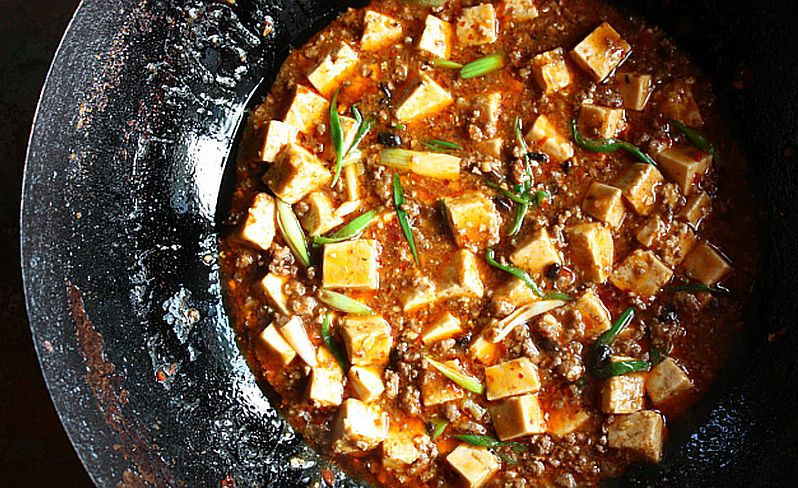
The other day I read that due to La Nina, the winter of 2016-17 will likely be a bit colder than usual, and depending on where you live, a little wetter, too. Here in Santa Cruz, it’s been chillier than normal, drizzly and in the mornings somewhat foggy. The dreariness and cooler temperatures led me to make a batch of Sichuan mapo tofu (ma po dou fu in Mandarin). It’s a dish that I’ve loved since I was about ten years old.
Mapo tofu is a dish that I traveled to Chengdu in Sichuan Province to investigate while writing the Asian Tofu cookbook. My friends and I even ate at the original mapo tofu restaurant, only to be disappointed with an imbalance of flavors -- too much spicy heat to the point where you couldn't taste anything, and it was super oily like a lot of food in mainland China. Sichuan food is about balancing flavors, we were told over and over. It's not about blowing out your taste buds.
Good Tofu for Mapo
I've been making mapo tofu for decades and have gained a fair amount of insights. For excellent mapo tofu, choose tofu with a little give to it. That is, no super-firm tofu sold in vacuum-sealed packages. That stuff is great for baked tofu or grating because it’s incredibly dense. In saucy preparations like mapo tofu, it doesn’t absorb flavors well. It’s just rubbery and fights with the sauce.
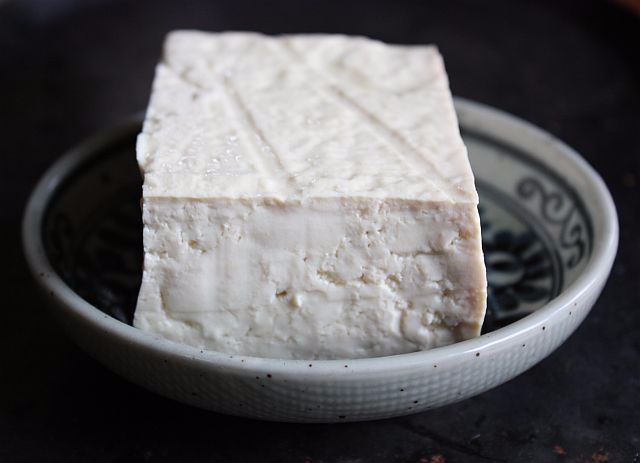
When making mapo tofu, I use a medium or medium-firm tofu, such as the “regular” tofu sold at Trader Joe’s. It gives just the right amount yet is still silky and supple for this dish. You can opt for "firm" but the mapo tofu will not be as luscious. For pointers on buying and judging tofu types, watch this video.
The tofu is cut then given a hot water soak. That draws out moisture and helps the soft-ish tofu withstand the bubbling and cooking in the wok. NO PRESSING of the tofu is needed. Just cut the cubes and prep. And, do not worry if the tofu cubes break apart. That is tofu's nature.
Chile Bean Sauce and Peppercorn Tips
Secondly, the chile bean sauce –- dou ban jiang should not be wimpy. I favor these brands sold at Asian markets. The Pixian kind is fabulously gutsy whereas the Taiwanese brand is a touch milder. A chile bean sauce buying guide is here.
Here are photos from a Sichuan chile bean sauce maker. They regularly stir the mixture and it ages for a long time.
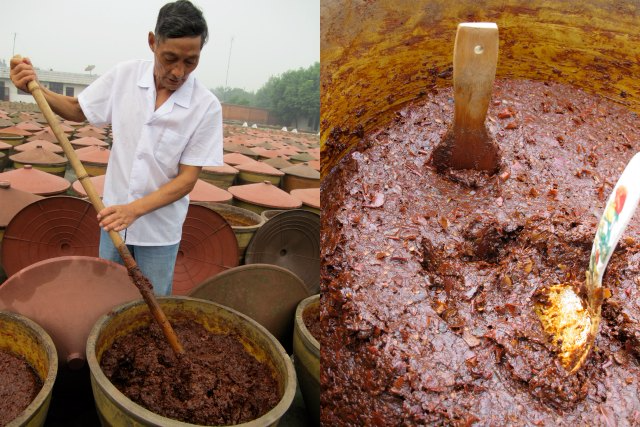
The amount of Sichuan peppercorn should be added per its taste and quality. If yours are mild or a little wimpy, use more. The amount suggested in the recipe is what I use for a moderate level of zingy numbing heat.
There was a time when they weren’t sold in America at all. I just saw organic ones by Spicely at my local Safeway supermarket in the spice aisle!
Toast the peppercorns in the wok or your skillet then pound them in a mortar and pestle. That insures the biggest and freshest flavor. There are many kinds of Sichuan peppercorns to check out.
Some people like their mapo tofu to have a thick sauce while others like a thinner sauce. You control that with the cornstarch. There are many ways to season mapo tofu. The black fermented beans add umami depth. Dried chile flakes impart heat that’s different than the chile bean paste and Sichuan peppercorns.
And, if you want to make it like they do in Sichuan, use beef -- a fatty, flavorful ground beef is best and be generous with the oil. Pork is okay but chicken or turkey don’t stand up to the other ingredients well enough. If you're interesed in a meatless version, try my best recipe for vegetarian mapo tofu (photo below).
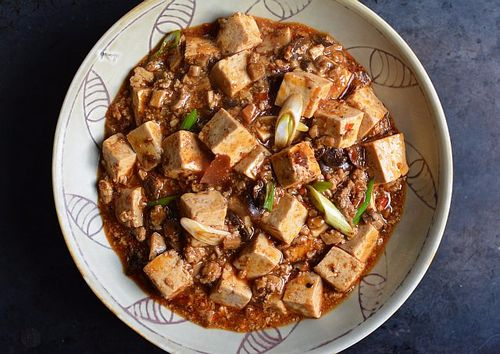
As renowned Chengdu chef and restaurateur Yu Bo told me when I visited, the key elements of ma po tofu are: “dou fu, niu rou, Pixian dou ban jiang!” (tofu, beef, and Pixian chile bean sauce!).
Mapo tofu is a hearty dish. Surrounded by mountains and located in a basin, Chengdu is known for its foggy weather (the smog doesn’t help either). If I lived there, I’d want a brow wiper like mapo tofu to cut through the haze and awaken the senses.
Related Posts
- Tofu buying guide video
- Chile bean sauce (dou ban jiang) buying guide
- Sichuan Peppercorns to try
- Vegetarian Ma Po Tofu recipe
Below is my go-to mapo tofu recipe from my book, Asian Tofu (Ten Speed Press, 2012). I've used it for years and know it's a keeper!
Mapo Tofu
Ingredients
- 14 to 16 ounces medium or medium-firm tofu
- 1 generous teaspoon Sichuan peppercorn
- 3 tablespoons canola oil
- 6 ounces ground beef or pork, fattier kind preferred, roughly chopped to loosen
- 1 teaspoon minced fresh ginger
- ½ teaspoon dried chile flakes, optional
- 1 tablespoon fermented black beans, optional
- 2 ½ to 3 tablespoons chile bean sauce, Pixian kind preferred
- 1 generous teaspoon sugar
- 2 teaspoons regular soy sauce
- Salt
- 2 large green onions, white and green parts, cut on the diagonal into pieces about 1 ½ inches long
- 1 ½ tablespoons cornstarch dissolved in 3 tablespoons water
Instructions
- Cut the tofu into ½-inch cubes and put into a bowl. Bring a kettle of water to a rolling boil. Turn off the heat and when the boiling subsides, pour water over the tofu to cover. Set aside for 15 minutes.
- Meanwhile, measure out 1 ⅓ cups of water (the stuff you just boiled is fine) and set aside near the stove. You’ll be using it later for the sauce.
- In a large wok or skillet, toast the peppercorn over medium heat for 2 to 3 minutes, until richly fragrant and slightly darkened; you may see a wisp of smoke. Let it cool briefly, then pound with a mortar and pestle or grind in a spice grinder. Set aside.
- Drain the tofu in a strainer or colander and put it near the stove. As with all stir-fries, assemble your ingredients next to the stove.
- Heat the oil in the wok or skillet over high heat. Add the beef, stirring and mashing into small pieces until crumbly and cooked through, about 2 minutes. Add the ginger, chile flakes, fermented black beans, and chile sauce. Cook for about 2 minutes, stirring constantly, until the beef is a rich reddish-brown color and the chile sauce has turned the oil slightly red. Add the sugar and soy sauce, stir to combine, then add the tofu. Gently stir or give the wok a shake to combine without breaking up the tofu much.
- Pour in the 1 ⅓ cups water you set aside earlier. Bring to a vigorous simmer, and cook for about 3 minutes to allow the tofu to absorb the flavors of the sauce.
- Taste the sauce and add a pinch of salt or sugar, if needed. Add the green onion and stir to combine. Give the cornstarch one last stir, then pour enough into the wok to thicken the sauce. You may not need to use it all. In Sichuan, the sauce is more soupy than gravylike. Sprinkle in the ground peppercorn, give the mixture one last stir to incorporate, then transfer to a shallow bowl. Serve immediately with lots of hot rice.













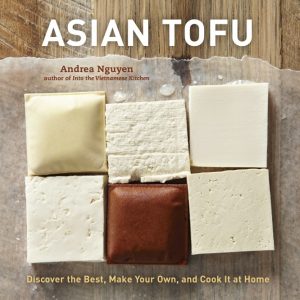





Tiffany Cheng says
Thank you for this recipe, I appreciate it.
Dennis Reed says
Your recipYour recipe is similar to the one I have used for years ... but I a 1-2 cubes of dofo ru for extra umami ... does not affect taste.
Dennis Reed says
Your recipYour recipe is similar to the one I have used for years ... but I a 1-2 cubes of dofo ru for extra umami ... does not affect taste. I also prefer mapo dofu over soft noodles.
Annie N says
Working from home and sheltering in place. I had all the ingredients on hand for a change. So quick and easy. And of course delicious. Didn't add the Sichuan peppercorns since I didn't have it and it was still fabulous.